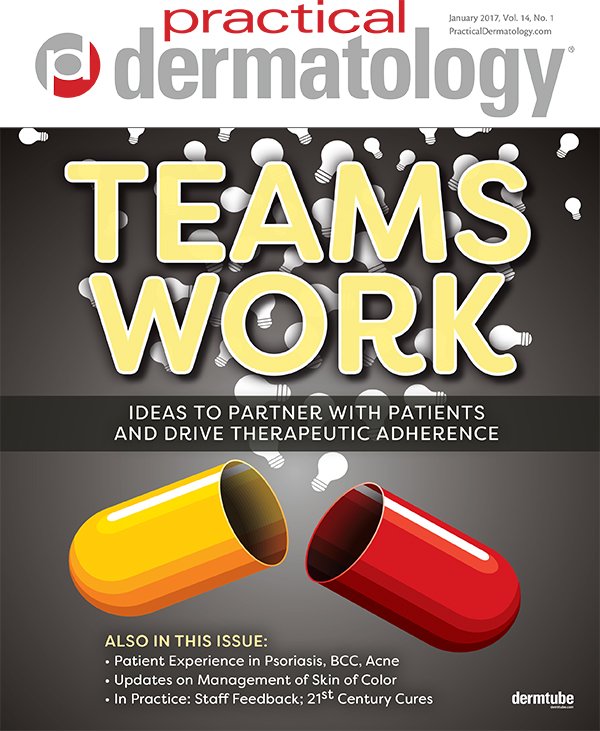In early 2016, the American Academy of Dermatology published updated guidelines1 for the care of patients with acne vulgaris. Members of the workgroup reviewed the currently available literature on acne medications and assessed the reliability of the data to provide guidelines on best practices for the treatment of acne patients. The following article will help summarize the guidelines on the use of systemic medications including antibiotics, hormonal therapies, and isotretinoin.
ORAL ANTIBIOTICS
Oral antibiotics are indicated for acne patients with moderate-to-severe disease and inflammatory acne who have demonstrated resistance to topical therapies. In addition, oral antibiotics may be considered in patients who have large surface areas of skin involved.
Antibiotics are thought to treat acne through their antimicrobial properties, namely reducing the levels of P. acnes bacteria in the sebaceous follicle. Some antibiotics also have inherent anti-inflammatory properties. Tetracyclines, for example, reduce inflammatory cell chemotaxis, decrease the activity of matrix metalloproteinases, and reduce P acnes-produced lipases.
When selecting an antibiotic to treat acne, lipophilic drugs are best as they penetrate into the lipid-filled environment of the sebaceous follicle, which is where the pathology in acne occurs. Appropriate antibiotics include tetracyclines such as doxycycline and minocycline, macrolides such as erythromycin, azithromycin, clindamycin, and finally trimethoprim. Tetracycline antibiotics should be considered first-line for all patients. Contraindications include known allergies, children less than eight years old, and pregnancy. There is limited data on the use of non-tetracycline class antibiotics for acne and these should be prescribed when tetracyclines cannot be used.
Antibiotic resistance is a global phenomenon. While dermatologists represent one percent of healthcare providers in the United States, we prescribe approximately five percent of all antibiotics. In fact, 54 percent of all prescriptions written for acne by dermatologists are topical or oral antibiotics. Both correct and incorrect use of antibiotics promotes bacterial resistance, and resistance is on the rise. The best practice for prescribing antibiotics for acne is to limit the use of oral antibiotics to the shortest period of time possible and evaluate patients after three to four months. Oral antibiotics should be combined with topical benzoyl peroxide or a topical retinoid when therapy is initiated. Finally, oral antibiotics should not be used as monotherapy, and should not be used as a maintenance-type treatment.
HORMONAL THERAPIES
The predominant hormonal therapies to treat acne in the United States include oral contraceptive pills and spironolactone. Hormonal therapy should be considered in patients with hyperandrogenemia, late-onset or persistent acne into adulthood, acne on the lower third of the face and neck, and patients with a history of a perimenstrual flare. Hormonal therapy may also be used when patients are resistant to previous conventional therapies or as an alternative to isotretinoin.
Estrogen-containing combination oral contraceptive pills are recommended for women with inflammatory acne. They work in several ways. First, they increase sex hormone-binding globulin and decrease free testosterone levels. They also decrease the conversion of testosterone to its more active form, dihydrotestosterone, by decreasing the activity of the 5 alpha reductase enzyme. Finally, oral contraceptive pills decrease sebum production.
Oral contraceptives are indicated for women who are at least 15 years old and have reached menarche. Patients should have inflammatory acne of at least moderate severity, desire contraception, and plan to take the birth control pill for at least six months.
Contraindications for oral contraceptive pills include age above 35, current pregnancy, a history of breast cancer, heavy smoking, history of hypercoagulability (deep venous thrombosis or pulmonary embolism), and a history of migraine with aura.
Spironolactone is a synthetic steroid and aldosterone antagonist. It competes with aldosterone for binding at the androgen receptor in the skin. It is typically dosed between 50 and 200 mg per day, usually in divided doses. Efficacy is seen after approximately three months. Spironolactone side effects include dose-dependent breast tenderness and menstrual irregularities, hyperkalemia (which has not been found to be significant), lightheadedness, and a diuretic effect. It is labeled as pregnancy category C or D depending on the source, and the drug carries a black box warning as it was associated with the development of solid organ tumors in mice when used at very high doses.
A recent publication in JAMA Dermatology found that only 13 potassium abnormalities were found in 1,800 lab tests of patients taking spironolactone which resolved when re-tested.2 The authors concluded that the incidence of hyperkalemia in young, healthy women is equivalent to the general population and regular monitoring of potassium is not necessary. Despite the published findings, many key opinion leaders are weary to stop checking laboratory tests in patients taking spironolactone. Population-based studies don’t account for outliers in clinical practice, so you must use your best clinical judgment when treating each individual patient.
ISOTRETINOIN
Isotretinoin is the only available acne medication that addresses all of the major pathogenic factors that cause acne. It is indicated for patients with severe, nodular acne, or in patients with moderate acne who have been resistant to traditional therapies. Finally, isotretinoin may be considered in patients with acne-producing physical scarring or psychosocial stress.
Isotretinoin is a lipophilic drug and should be taken with a high-fat, high-calorie meal. In the absence of food, less than half the concentration of the drug is systemically absorbed. This means that the effective dose for a patient may be very different from the actual prescribed dose. Several studies have evaluated the link between inflammatory bowel disease and the use of isotretinoin. Some studies have noted an association between the drug and the development of ulcerative colitis, but not Crohn’s disease. The largest study to date—a 2014 French nationwide study—evaluated 7,600 cases of patients with inflammatory bowel disease and 30,000 matched controls. Investigators concluded that isotretinoin exposure was not associated with ulcerative colitis. Moreover, exposure was associated with a decreased risk of developing Crohn’s disease.3 An editorial that accompanied the new study stated that it “provides the best evidence to date that there is no causal association.”4
Traditionally, blood work is drawn once monthly in all patients on isotretinoin for the duration of therapy. However, a meta-analysis published in JAMA Dermatology evaluated whether this was necessary. The authors concluded that if there are no abnormalities after two months of isotretinoin, monthly testing may not be necessary.5 As in the case of laboratory monitoring when treating patients on spironolactone, dermatologists should use their best clinical judgment in treating individual patients. The AAD guidelines task force recommends routine monitoring of liver function test, serum cholesterol, and triglycerides. The lab test should be ordered at baseline and again “until response to treatment is established.”1 Routine complete blood count testing is not recommended.
We currently have a large tool kit of oral therapies to treat our patients with acne. These drugs include antibiotics, hormonal therapies, and isotretinoin. All three classes of medications are effective, but they may carry individualized risks and should be carefully selected and monitored. When balancing safety and efficacy, these drugs can help provide our patients with excellent therapeutic outcomes.
Dr. Joshua Zeichner is the Director of Cosmetic and Clinical Research in Dermatology at Mt. Sinai Hospital and an Assistant Professor in the Dermatology Department at Mt Sinai Medical Center in Manhattan.
1. Zaenglein AL, Pathy AL, Schlosser, BL, et al. Guidelinesof care for the management ofacne vulgaris. J Am Acad Dermatol.2016May;74(5):945-73.
2. Plovanich M, et al. Low Usefulness of Potassium Monitoring Among Healthy Young Women Taking Spironolactone for Acne. JAMA Dermatol. 2015;151(9):941-944.
3. Racine A, Cuerg A, Bijon A, et al. Isotretinoin and risk of inflammatory bowel disease: a French nationwide study. Am J Gastroenterol.2014 Apr;109(4):563-9.
4. Tenner S. Isotretinoin and inflammatory bowel disease: trial lawyer misuse of science and FDA warnings. Am J Gastroenterol.2014 Apr;109(4):570-1.
5. Lee YH, Scharnitz TP, Muscat J, et al. Laboratory Monitoring During Isotretinoin Therapy for Acne: A Systematic Review and Meta-analysis. JAMA Dermatol.2016Jan;152(1):35-44.


